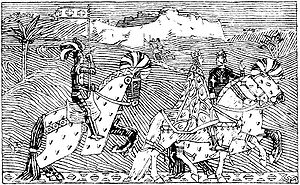Siege of Sidon
| Siege of Sidon | |||||||||
|---|---|---|---|---|---|---|---|---|---|
| Part of the Norwegian Crusade | |||||||||
 King Sigurd and King Baldwin ride from Jerusalem to the river Jordan by Gerhard Munthe | |||||||||
| |||||||||
| Belligerents | |||||||||
|
| |||||||||
| Commanders and leaders | |||||||||
| Governor of Sidon[a] | |||||||||
| Strength | |||||||||
|
Franks
Venetians
|
Fatimids
| ||||||||
| Casualties and losses | |||||||||
| unknown, but probably minor | unknown, but probably large | ||||||||
The siege of Sidon was an event in the aftermath of the First Crusade. The coastal city of Sidon was captured by the forces of Baldwin I of Jerusalem and Sigurd I of Norway, with assistance from the Ordelafo Faliero, Doge of Venice.
Background
[edit]In August 1108, Baldwin I marched out against Sidon, with the support of a squadron of sailor-adventurers from various Italian cities. However, the Egyptian fleet defeated the Italians in a sea-battle outside the harbour.[2] Upon the arrival of additional Turkish horsemen from Damascus, Baldwin decided to lift the siege.
In the summer of 1110, a Norwegian fleet of 60 ships arrived in the Levant under the command of King Sigurd. Arriving in Acre he was received by Baldwin I, King of Jerusalem. Together they made a journey to the river Jordan, after which Baldwin asked for help in capturing Muslim-held ports on the coast. Sigurd's answer was that "they had come for the purpose of devoting themselves to the service of Christ", and accompanied him to take the city of Sidon, which had been re-fortified by the Fatimids in 1098.
The siege
[edit]Baldwin's army besieged the city by land, while the Norwegians came by sea. A naval force was needed to prevent assistance from the Fatimid fleet at Tyre. Repelling it was however only made possible with the fortunate arrival of a Venetian fleet. The city fell after 47 days.
The Icelandic skald Einarr Skúlason gives the following account.
|
|
Aftermath
[edit]When the city surrendered, King Baldwin gave the same terms of surrender he had previously given to Arsuf and Acre. He allowed safe conduct of passage for those leaving and even allowed some members of the Muslim populace to remain in peace.[3]
By order of Baldwin and the Patriarch of Jerusalem, Ghibbelin of Arles, a splinter was taken off the holy cross and given to Sigurd.
The Lordship of Sidon was created and given to Eustace Grenier, later a constable of the Kingdom of Jerusalem.
Notes
[edit]References
[edit]- ^ Store norske leksikon - Sigurd 1 Magnusson Jorsalfare – utdypning (NBL-artikkel)
- ^ Steven Runciman (1952). A History of The Crusades. Vol II: The Kingdom of Jerusalem, p. 74. ISBN 978-0-241-29876-3.
- ^ The Crusades by Thomas Asbridge, p. 125
Sources
[edit]- Battles and sieges, Tony Jaques
- The Crusades and the expansion of Catholic Christendom, 1000–1714, John France
- The Second Crusade, Jonathan Phillips
- The chronicle of Ibn al-Athīr for the crusading period from al-Kāmil fīʼl-taʼrīkh, ʻIzz al-Dīn Ibn al-Athīr and Donald Sidney
- Saga of Sigurd the Crusader and His Brothers Eystein and Olaf
